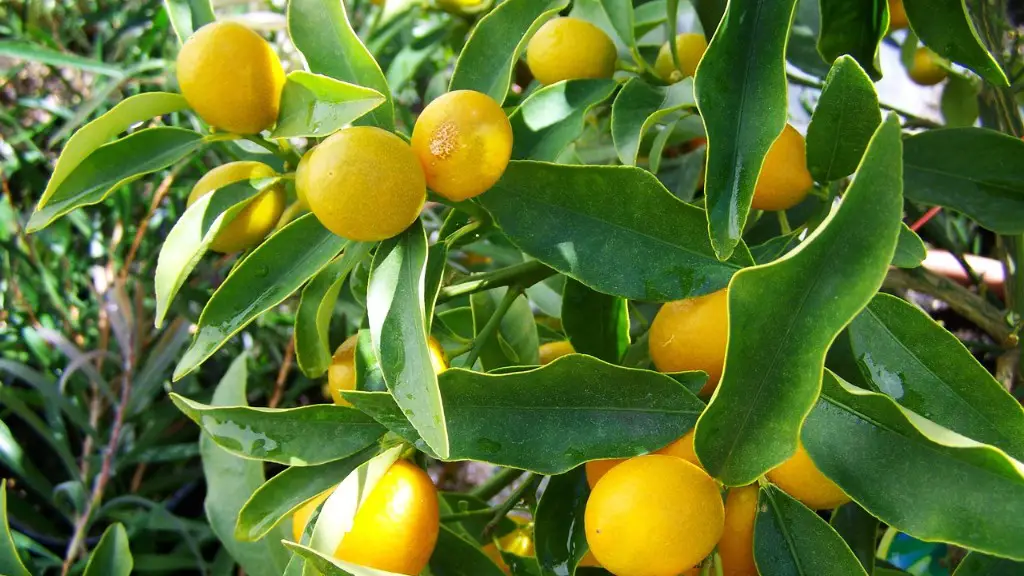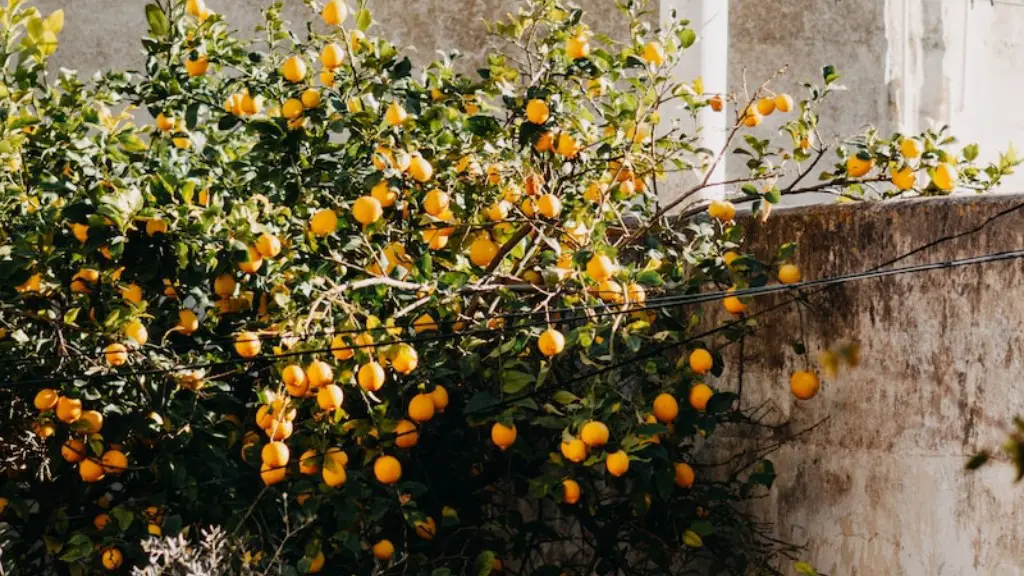Lemon trees are native to warm, humid climates and cannot tolerate cold temperatures. If the temperature falls below freezing, the tree will be damaged and its fruit will be ruined. Frost can kill a lemon tree outright, so it is important to protect the tree from the cold if you live in an area where the temperature can drop below freezing.
A lemon tree can withstand temperatures as low as 29 degrees Fahrenheit.
Can lemon trees tolerate 40 degrees?
If you have a Meyer lemon tree, it is important to know how cold is too cold for the tree. If the tree is mature, a short bout of frost is not likely to kill the tree, but damage and death is possible if temperatures below 29 degrees Fahrenheit are sustained. Younger trees should not be introduced to prolonged temperatures below 40 degrees.
Citrus trees are fairly resilient and can handle light frosts without too much damage. However, any temperature below 32°F can be detrimental to its health. If you live in an area with a risk of frost, it’s best to keep your tree inside until the last spring frost has passed and the average nightly temperature is above 40°F. This will help ensure that your citrus tree stays healthy and thrives.
Can lemon trees survive 30 degrees
If you are growing lemons, limes, or grapefruit, you will need to take extra care to protect them from cold weather. These fruits are less cold tolerant than other types of citrus, and can be damaged by temperatures as low as 28-30 degrees. If a hard freeze is expected, it is best to harvest all of your citrus fruit before it hits. It only takes 10 hours of exposure to cold temperatures to ruin these fruits.
The main limiting factor for growing citrus is the lack of significant cold tolerance. The ideal temperature range for citrus is between 60- and 90-degrees F, though depending on the species and cultivar, some have better cold tolerance than others. Citrus trees are not able to withstand freezing temperatures for long periods of time, so they are typically only grown in warmer climates.
When should you bring a lemon tree inside?
When the temperatures start to drop below 40 degrees Fahrenheit, it is time to bring your citrus trees indoors. Surprisingly, most citrus trees can handle a mild freeze or two. However, it is best to avoid that exposure, especially if your tree has flowers or fruit on it.
You can protect your tree and the fruit left on it from freezing by covering it with a blanket or heavy tarp on those nights where it is predicted to dip below freezing. To do this, build tripods of light lumber or PVC pipe around the trees and cover them with frost cloth or tarps on the coldest nights.
How do you winterize a lemon tree?
To ensure your indoor citrus trees remain healthy during the winter months, follow these care tips:
– lower the room temperature to 58-68 degrees;
– provide supplemental lighting if necessary;
– rotate the plant regularly;
– fertilize monthly;
– improve air circulation;
– water properly; and
– watch for pests.
Meyer Lemon Trees are very cold hardy and can withstand temperatures down to about 20 degrees. If your area gets colder than that, your tree will need to be planted in a container and brought inside when the temperature drops. But when they’re inside, winter heat can dry them out.
Where do I put my potted lemon tree in the winter
Citrus trees need humid, well-ventilated conditions with plenty of light to thrive. They are not well suited to dry, hot, or stuffy environments. Central heating can dry out the air and make it difficult for citrus trees to get the humidity they need. If you have a citrus tree, consider placing it on a porch or in another area with good air circulation.
The freezing temperature can damage the satsuma fruit and other citrus fruits. The fruit will become brown and shriveled, and the juice will become bitter. To prevent this from happening, pick the fruit before the temperature drops below 30 degrees Fahrenheit, or wrap the fruit in a blanket or burlap bag to protect it from the cold.
How cold is too cold for citrus trees in pots?
Citrus trees are frost-sensitive and may be damaged when exposed to temperatures below freezing. In warmer climates, potted citrus trees should be moved indoors when cold weather is forecast. In USDA zones 8 and below, trees should be protected when temperatures are expected to fall to 29-32°F for 30 minutes or more.
Mature citrus trees are pretty hardy and can withstand light frosts without too much issue. However, if you’re expecting a hard frost, it’s a good idea to wrap the trunks of the trees with insulation material. This will help protect them from the cold and prevent any damage.
Can I leave my lemon tree outside
Citrus fruits are a great addition to any garden, and they can be grown in pots outdoors. However, it is important to only put them out when temperatures have increased, from mid-June until late September. Keep some fleece handy in case of sudden cold nights in early summer. Low temperatures will inhibit flowering and may cause damage or even death.
Growing a lemon tree in a pot is a great way to enjoy the fresh taste of homegrown lemons, even if you don’t live in a warm climate. All you need is a healthy tree and a little bit of know-how to keep it happy.
Lemon trees need a lot of sunlight, so pick a spot in your home that gets plenty of light. They also prefer warm temperatures, so if your home is on the cooler side, you may need to provide some extra heat. A good way to do this is to place the pot on a warm, sunny windowsill.
Water your lemon tree regularly, making sure the soil is evenly moist but not soggy. Let the top inch or so of soil dry out before watering again. Fertilize your tree every few weeks with a citrus fertilizer to help it grow strong and produce lots of fruit.
With a little care, your lemon tree will thrive indoors and provide you with an abundance of fresh lemons to enjoy.
Where should I put my lemon tree in my house?
If you’re hoping to grow a lemon tree indoors, you’ll need to give it a ton of bright light every day—at least 10 hours. The best place for it to get that light would be in a south-facing window. Without enough light, the plant won’t produce flowers, and therefore won’t produce fruit.
If you experience cooler weather during the fall and winter months, growing a potted lemon tree indoors is a great way to sustain the plant all year long. Since these trees are self-pollinating, only one is needed to produce fruit.
How often should I water my potted lemon tree in winter
although you may not need to water your mature citrus tree as frequently in the fall, it is important to water it deeply whenever you do. This will help to ensure that the roots get the moisture they need. A little dot on your calendar can help you keep track of your watering days.
There are various approaches that can be taken in order to help a freeze-damaged citrus tree recover. The approach that is best suited for a particular tree will depend on several factors, including the time of year, the condition of the tree, and the weather conditions after the freeze. With proper care and attention, however, many freeze-damaged citrus trees can make a full recovery.
Conclusion
A lemon tree can stand cold temperatures down to around 28°F. However, they will likely experience damage to their leaves and fruit if exposed to temperatures below freezing.
Lemon trees can tolerate temperatures as low as 28 degrees Fahrenheit, provided they are not subjected to extended periods of cold weather. However, if the temperature drops below 28 degrees Fahrenheit and remains there for more than a few hours, the tree will likely suffer damage to its leaves and fruit. Once the tree has been damaged, it is less resistant to future cold snaps. Therefore, it is important to protect lemon trees from extended periods of cold weather, especially if the temperature is expected to dip below 28 degrees Fahrenheit.




